Evaluating Green Logistics Strategies: A Sustainability Case Study
VerifiedAdded on 2022/08/28
|14
|3539
|16
Case Study
AI Summary
This case study delves into the concept of green logistics, emphasizing its role in sustainability and environmental responsibility within supply chain management. It explores how companies are integrating green logistics practices to reduce their environmental impact and enhance operational efficiency. The report examines the relationship between sustainability strategies and the implementation of green logistics in transportation, highlighting the positive effects on logistics effectiveness and efficiency. A real-world case study of Eroski, a Spanish food distributor, illustrates the application of green logistics principles and their contribution to the company's sustainability efforts by focusing on reducing the environmental impact of transportation activities through initiatives like the Green Transport Forum. This case demonstrates the practical implications of green logistics and its potential for improving both environmental and economic performance.

Running head: GREEN LOGISTICS
Green Logistics
Name of the Student
Name of the University
Author’s Note
Green Logistics
Name of the Student
Name of the University
Author’s Note
Paraphrase This Document
Need a fresh take? Get an instant paraphrase of this document with our AI Paraphraser
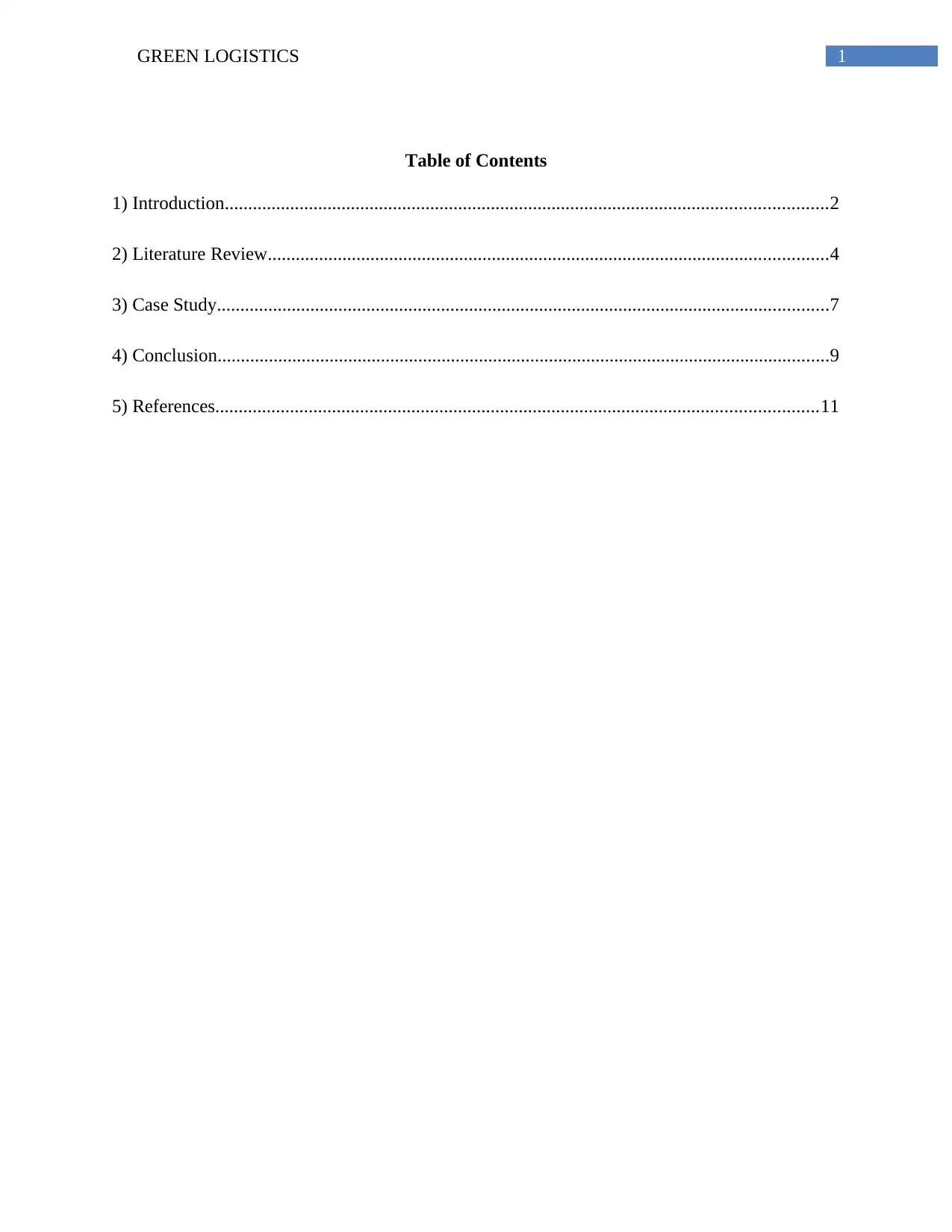
1GREEN LOGISTICS
Table of Contents
1) Introduction.................................................................................................................................2
2) Literature Review........................................................................................................................4
3) Case Study...................................................................................................................................7
4) Conclusion...................................................................................................................................9
5) References.................................................................................................................................11
Table of Contents
1) Introduction.................................................................................................................................2
2) Literature Review........................................................................................................................4
3) Case Study...................................................................................................................................7
4) Conclusion...................................................................................................................................9
5) References.................................................................................................................................11
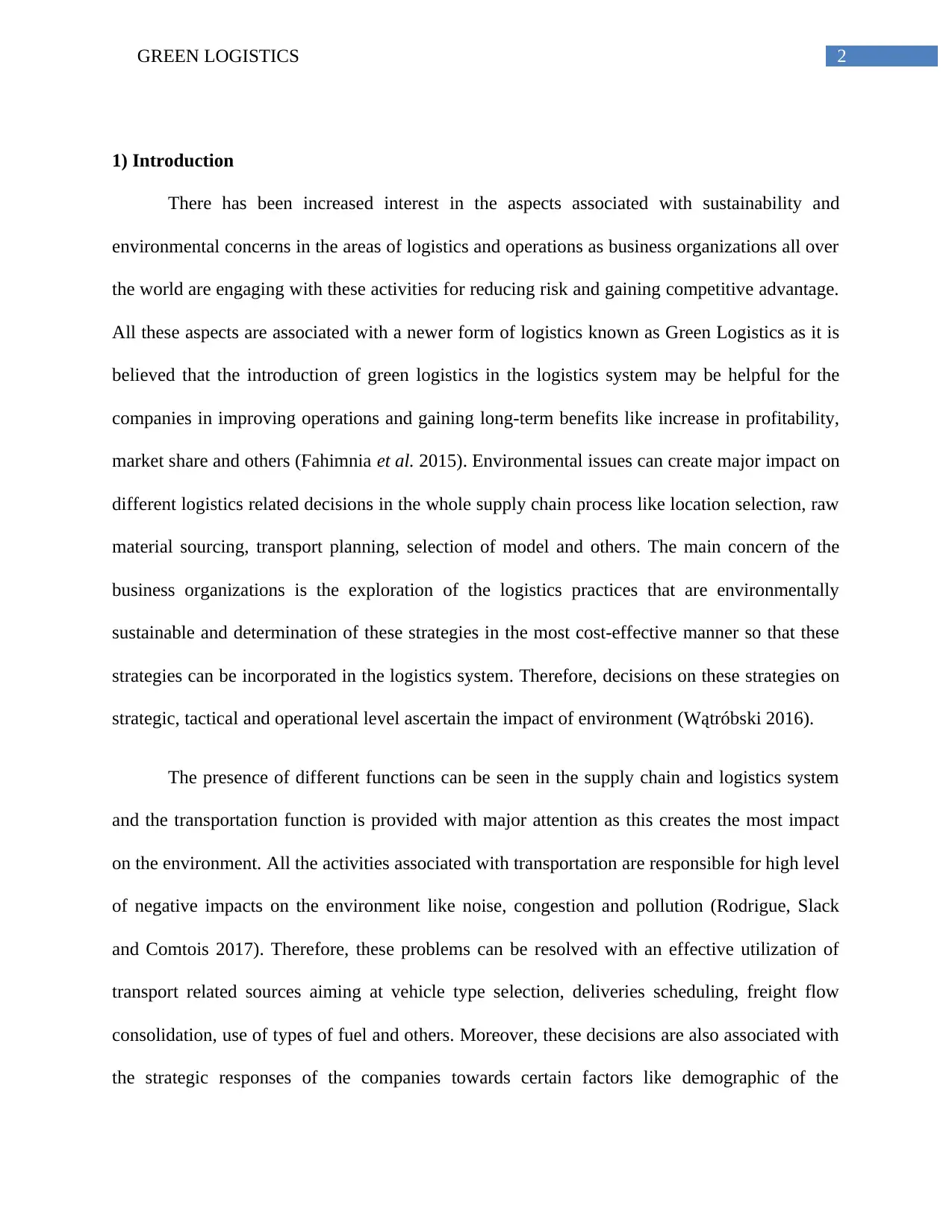
2GREEN LOGISTICS
1) Introduction
There has been increased interest in the aspects associated with sustainability and
environmental concerns in the areas of logistics and operations as business organizations all over
the world are engaging with these activities for reducing risk and gaining competitive advantage.
All these aspects are associated with a newer form of logistics known as Green Logistics as it is
believed that the introduction of green logistics in the logistics system may be helpful for the
companies in improving operations and gaining long-term benefits like increase in profitability,
market share and others (Fahimnia et al. 2015). Environmental issues can create major impact on
different logistics related decisions in the whole supply chain process like location selection, raw
material sourcing, transport planning, selection of model and others. The main concern of the
business organizations is the exploration of the logistics practices that are environmentally
sustainable and determination of these strategies in the most cost-effective manner so that these
strategies can be incorporated in the logistics system. Therefore, decisions on these strategies on
strategic, tactical and operational level ascertain the impact of environment (Wątróbski 2016).
The presence of different functions can be seen in the supply chain and logistics system
and the transportation function is provided with major attention as this creates the most impact
on the environment. All the activities associated with transportation are responsible for high level
of negative impacts on the environment like noise, congestion and pollution (Rodrigue, Slack
and Comtois 2017). Therefore, these problems can be resolved with an effective utilization of
transport related sources aiming at vehicle type selection, deliveries scheduling, freight flow
consolidation, use of types of fuel and others. Moreover, these decisions are also associated with
the strategic responses of the companies towards certain factors like demographic of the
1) Introduction
There has been increased interest in the aspects associated with sustainability and
environmental concerns in the areas of logistics and operations as business organizations all over
the world are engaging with these activities for reducing risk and gaining competitive advantage.
All these aspects are associated with a newer form of logistics known as Green Logistics as it is
believed that the introduction of green logistics in the logistics system may be helpful for the
companies in improving operations and gaining long-term benefits like increase in profitability,
market share and others (Fahimnia et al. 2015). Environmental issues can create major impact on
different logistics related decisions in the whole supply chain process like location selection, raw
material sourcing, transport planning, selection of model and others. The main concern of the
business organizations is the exploration of the logistics practices that are environmentally
sustainable and determination of these strategies in the most cost-effective manner so that these
strategies can be incorporated in the logistics system. Therefore, decisions on these strategies on
strategic, tactical and operational level ascertain the impact of environment (Wątróbski 2016).
The presence of different functions can be seen in the supply chain and logistics system
and the transportation function is provided with major attention as this creates the most impact
on the environment. All the activities associated with transportation are responsible for high level
of negative impacts on the environment like noise, congestion and pollution (Rodrigue, Slack
and Comtois 2017). Therefore, these problems can be resolved with an effective utilization of
transport related sources aiming at vehicle type selection, deliveries scheduling, freight flow
consolidation, use of types of fuel and others. Moreover, these decisions are also associated with
the strategic responses of the companies towards certain factors like demographic of the
⊘ This is a preview!⊘
Do you want full access?
Subscribe today to unlock all pages.

Trusted by 1+ million students worldwide
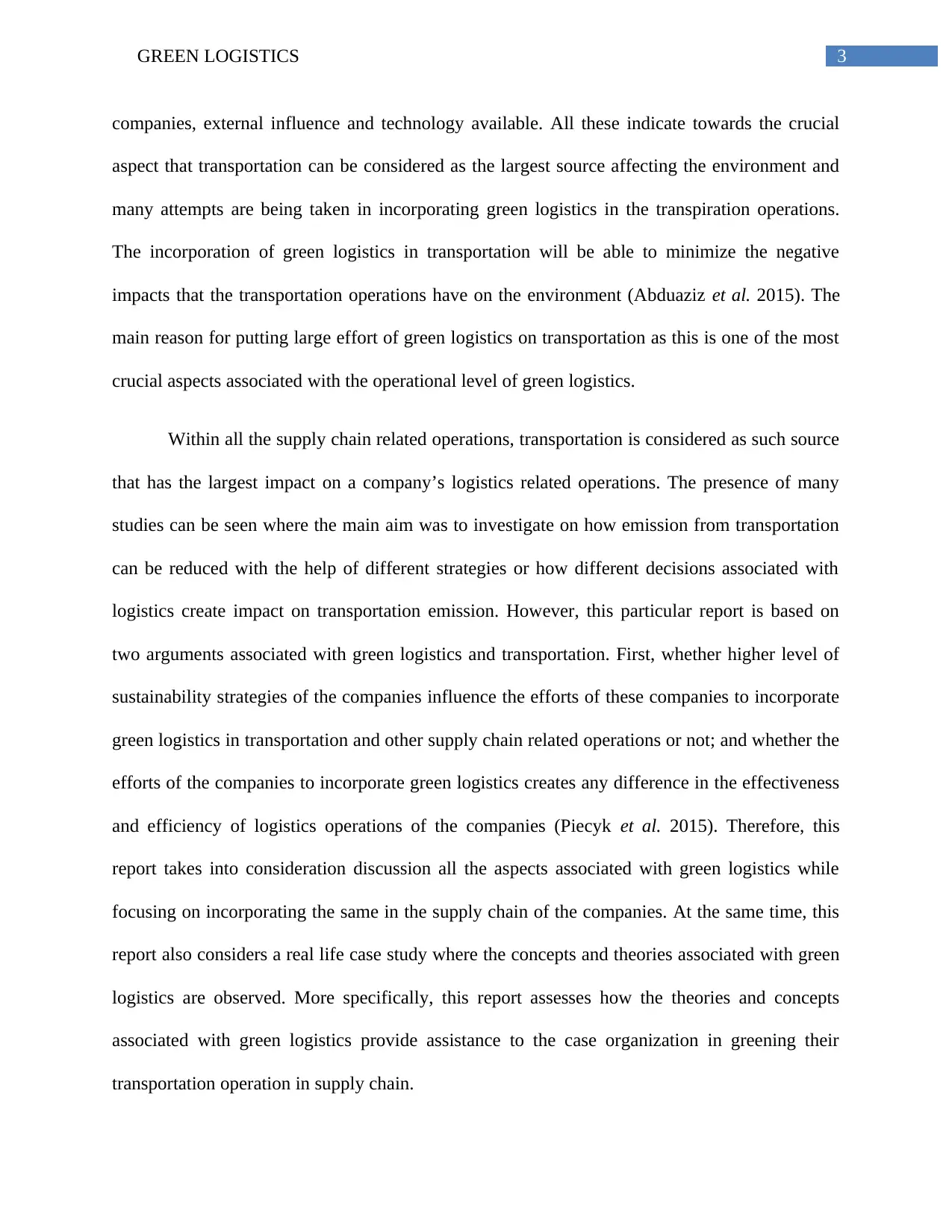
3GREEN LOGISTICS
companies, external influence and technology available. All these indicate towards the crucial
aspect that transportation can be considered as the largest source affecting the environment and
many attempts are being taken in incorporating green logistics in the transpiration operations.
The incorporation of green logistics in transportation will be able to minimize the negative
impacts that the transportation operations have on the environment (Abduaziz et al. 2015). The
main reason for putting large effort of green logistics on transportation as this is one of the most
crucial aspects associated with the operational level of green logistics.
Within all the supply chain related operations, transportation is considered as such source
that has the largest impact on a company’s logistics related operations. The presence of many
studies can be seen where the main aim was to investigate on how emission from transportation
can be reduced with the help of different strategies or how different decisions associated with
logistics create impact on transportation emission. However, this particular report is based on
two arguments associated with green logistics and transportation. First, whether higher level of
sustainability strategies of the companies influence the efforts of these companies to incorporate
green logistics in transportation and other supply chain related operations or not; and whether the
efforts of the companies to incorporate green logistics creates any difference in the effectiveness
and efficiency of logistics operations of the companies (Piecyk et al. 2015). Therefore, this
report takes into consideration discussion all the aspects associated with green logistics while
focusing on incorporating the same in the supply chain of the companies. At the same time, this
report also considers a real life case study where the concepts and theories associated with green
logistics are observed. More specifically, this report assesses how the theories and concepts
associated with green logistics provide assistance to the case organization in greening their
transportation operation in supply chain.
companies, external influence and technology available. All these indicate towards the crucial
aspect that transportation can be considered as the largest source affecting the environment and
many attempts are being taken in incorporating green logistics in the transpiration operations.
The incorporation of green logistics in transportation will be able to minimize the negative
impacts that the transportation operations have on the environment (Abduaziz et al. 2015). The
main reason for putting large effort of green logistics on transportation as this is one of the most
crucial aspects associated with the operational level of green logistics.
Within all the supply chain related operations, transportation is considered as such source
that has the largest impact on a company’s logistics related operations. The presence of many
studies can be seen where the main aim was to investigate on how emission from transportation
can be reduced with the help of different strategies or how different decisions associated with
logistics create impact on transportation emission. However, this particular report is based on
two arguments associated with green logistics and transportation. First, whether higher level of
sustainability strategies of the companies influence the efforts of these companies to incorporate
green logistics in transportation and other supply chain related operations or not; and whether the
efforts of the companies to incorporate green logistics creates any difference in the effectiveness
and efficiency of logistics operations of the companies (Piecyk et al. 2015). Therefore, this
report takes into consideration discussion all the aspects associated with green logistics while
focusing on incorporating the same in the supply chain of the companies. At the same time, this
report also considers a real life case study where the concepts and theories associated with green
logistics are observed. More specifically, this report assesses how the theories and concepts
associated with green logistics provide assistance to the case organization in greening their
transportation operation in supply chain.
Paraphrase This Document
Need a fresh take? Get an instant paraphrase of this document with our AI Paraphraser
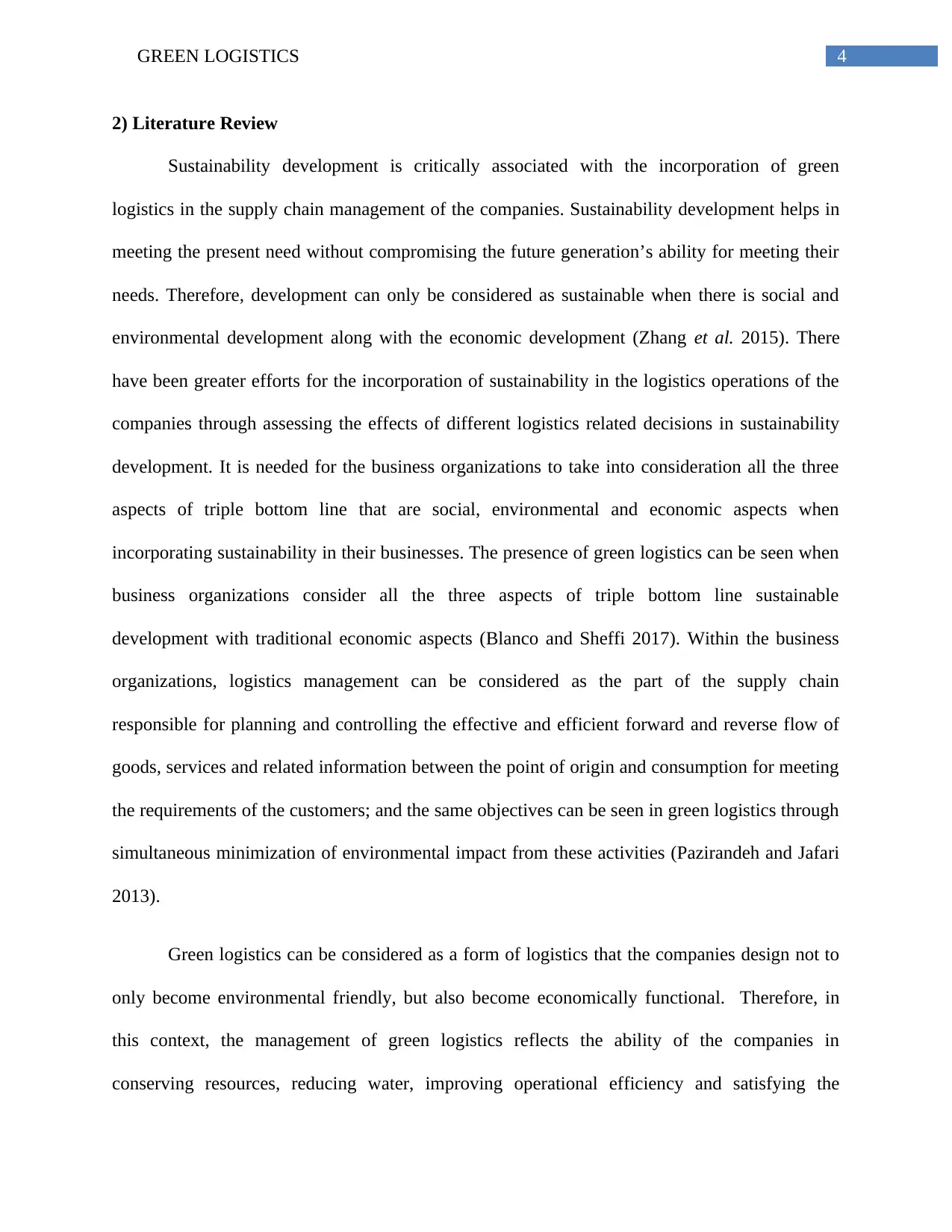
4GREEN LOGISTICS
2) Literature Review
Sustainability development is critically associated with the incorporation of green
logistics in the supply chain management of the companies. Sustainability development helps in
meeting the present need without compromising the future generation’s ability for meeting their
needs. Therefore, development can only be considered as sustainable when there is social and
environmental development along with the economic development (Zhang et al. 2015). There
have been greater efforts for the incorporation of sustainability in the logistics operations of the
companies through assessing the effects of different logistics related decisions in sustainability
development. It is needed for the business organizations to take into consideration all the three
aspects of triple bottom line that are social, environmental and economic aspects when
incorporating sustainability in their businesses. The presence of green logistics can be seen when
business organizations consider all the three aspects of triple bottom line sustainable
development with traditional economic aspects (Blanco and Sheffi 2017). Within the business
organizations, logistics management can be considered as the part of the supply chain
responsible for planning and controlling the effective and efficient forward and reverse flow of
goods, services and related information between the point of origin and consumption for meeting
the requirements of the customers; and the same objectives can be seen in green logistics through
simultaneous minimization of environmental impact from these activities (Pazirandeh and Jafari
2013).
Green logistics can be considered as a form of logistics that the companies design not to
only become environmental friendly, but also become economically functional. Therefore, in
this context, the management of green logistics reflects the ability of the companies in
conserving resources, reducing water, improving operational efficiency and satisfying the
2) Literature Review
Sustainability development is critically associated with the incorporation of green
logistics in the supply chain management of the companies. Sustainability development helps in
meeting the present need without compromising the future generation’s ability for meeting their
needs. Therefore, development can only be considered as sustainable when there is social and
environmental development along with the economic development (Zhang et al. 2015). There
have been greater efforts for the incorporation of sustainability in the logistics operations of the
companies through assessing the effects of different logistics related decisions in sustainability
development. It is needed for the business organizations to take into consideration all the three
aspects of triple bottom line that are social, environmental and economic aspects when
incorporating sustainability in their businesses. The presence of green logistics can be seen when
business organizations consider all the three aspects of triple bottom line sustainable
development with traditional economic aspects (Blanco and Sheffi 2017). Within the business
organizations, logistics management can be considered as the part of the supply chain
responsible for planning and controlling the effective and efficient forward and reverse flow of
goods, services and related information between the point of origin and consumption for meeting
the requirements of the customers; and the same objectives can be seen in green logistics through
simultaneous minimization of environmental impact from these activities (Pazirandeh and Jafari
2013).
Green logistics can be considered as a form of logistics that the companies design not to
only become environmental friendly, but also become economically functional. Therefore, in
this context, the management of green logistics reflects the ability of the companies in
conserving resources, reducing water, improving operational efficiency and satisfying the
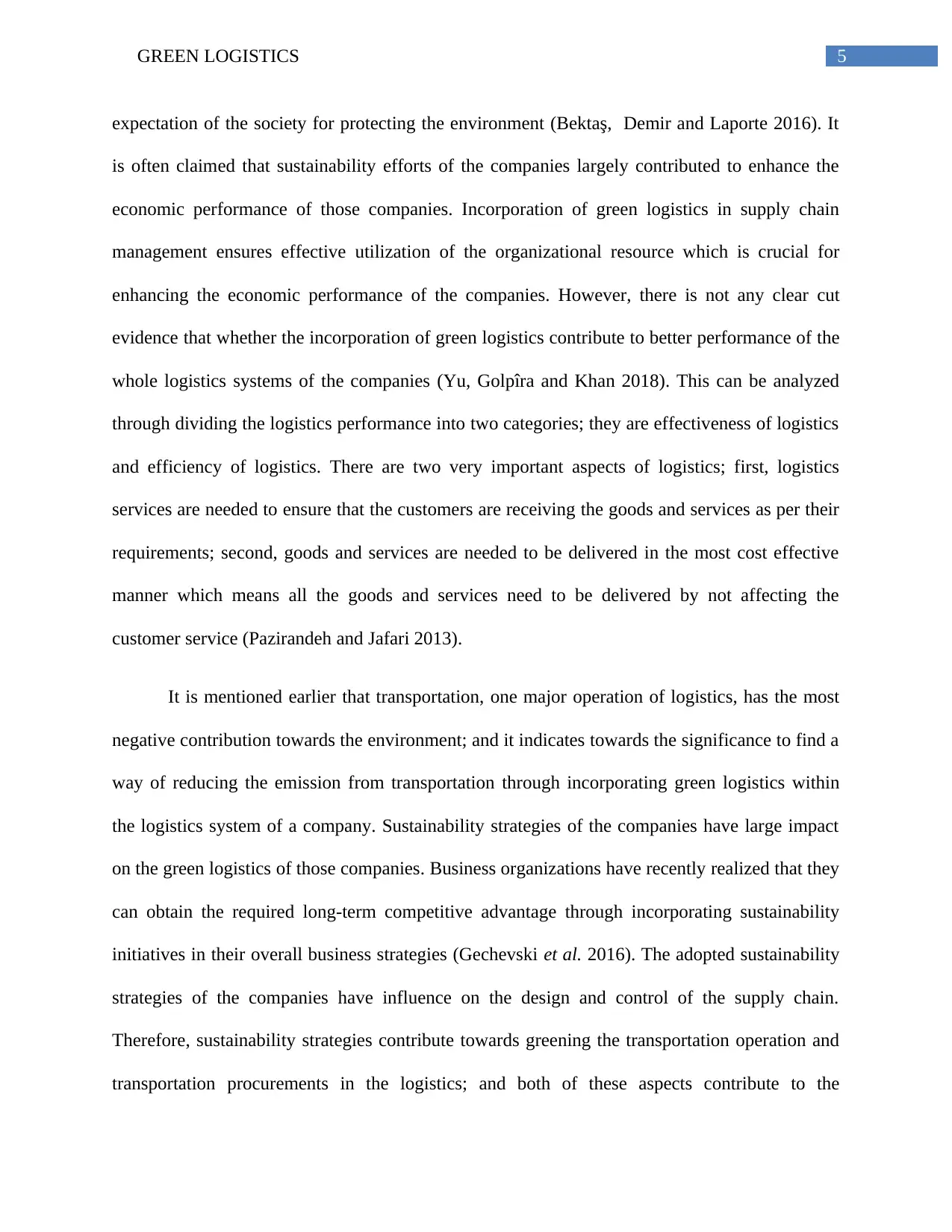
5GREEN LOGISTICS
expectation of the society for protecting the environment (Bektaş, Demir and Laporte 2016). It
is often claimed that sustainability efforts of the companies largely contributed to enhance the
economic performance of those companies. Incorporation of green logistics in supply chain
management ensures effective utilization of the organizational resource which is crucial for
enhancing the economic performance of the companies. However, there is not any clear cut
evidence that whether the incorporation of green logistics contribute to better performance of the
whole logistics systems of the companies (Yu, Golpîra and Khan 2018). This can be analyzed
through dividing the logistics performance into two categories; they are effectiveness of logistics
and efficiency of logistics. There are two very important aspects of logistics; first, logistics
services are needed to ensure that the customers are receiving the goods and services as per their
requirements; second, goods and services are needed to be delivered in the most cost effective
manner which means all the goods and services need to be delivered by not affecting the
customer service (Pazirandeh and Jafari 2013).
It is mentioned earlier that transportation, one major operation of logistics, has the most
negative contribution towards the environment; and it indicates towards the significance to find a
way of reducing the emission from transportation through incorporating green logistics within
the logistics system of a company. Sustainability strategies of the companies have large impact
on the green logistics of those companies. Business organizations have recently realized that they
can obtain the required long-term competitive advantage through incorporating sustainability
initiatives in their overall business strategies (Gechevski et al. 2016). The adopted sustainability
strategies of the companies have influence on the design and control of the supply chain.
Therefore, sustainability strategies contribute towards greening the transportation operation and
transportation procurements in the logistics; and both of these aspects contribute to the
expectation of the society for protecting the environment (Bektaş, Demir and Laporte 2016). It
is often claimed that sustainability efforts of the companies largely contributed to enhance the
economic performance of those companies. Incorporation of green logistics in supply chain
management ensures effective utilization of the organizational resource which is crucial for
enhancing the economic performance of the companies. However, there is not any clear cut
evidence that whether the incorporation of green logistics contribute to better performance of the
whole logistics systems of the companies (Yu, Golpîra and Khan 2018). This can be analyzed
through dividing the logistics performance into two categories; they are effectiveness of logistics
and efficiency of logistics. There are two very important aspects of logistics; first, logistics
services are needed to ensure that the customers are receiving the goods and services as per their
requirements; second, goods and services are needed to be delivered in the most cost effective
manner which means all the goods and services need to be delivered by not affecting the
customer service (Pazirandeh and Jafari 2013).
It is mentioned earlier that transportation, one major operation of logistics, has the most
negative contribution towards the environment; and it indicates towards the significance to find a
way of reducing the emission from transportation through incorporating green logistics within
the logistics system of a company. Sustainability strategies of the companies have large impact
on the green logistics of those companies. Business organizations have recently realized that they
can obtain the required long-term competitive advantage through incorporating sustainability
initiatives in their overall business strategies (Gechevski et al. 2016). The adopted sustainability
strategies of the companies have influence on the design and control of the supply chain.
Therefore, sustainability strategies contribute towards greening the transportation operation and
transportation procurements in the logistics; and both of these aspects contribute to the
⊘ This is a preview!⊘
Do you want full access?
Subscribe today to unlock all pages.

Trusted by 1+ million students worldwide
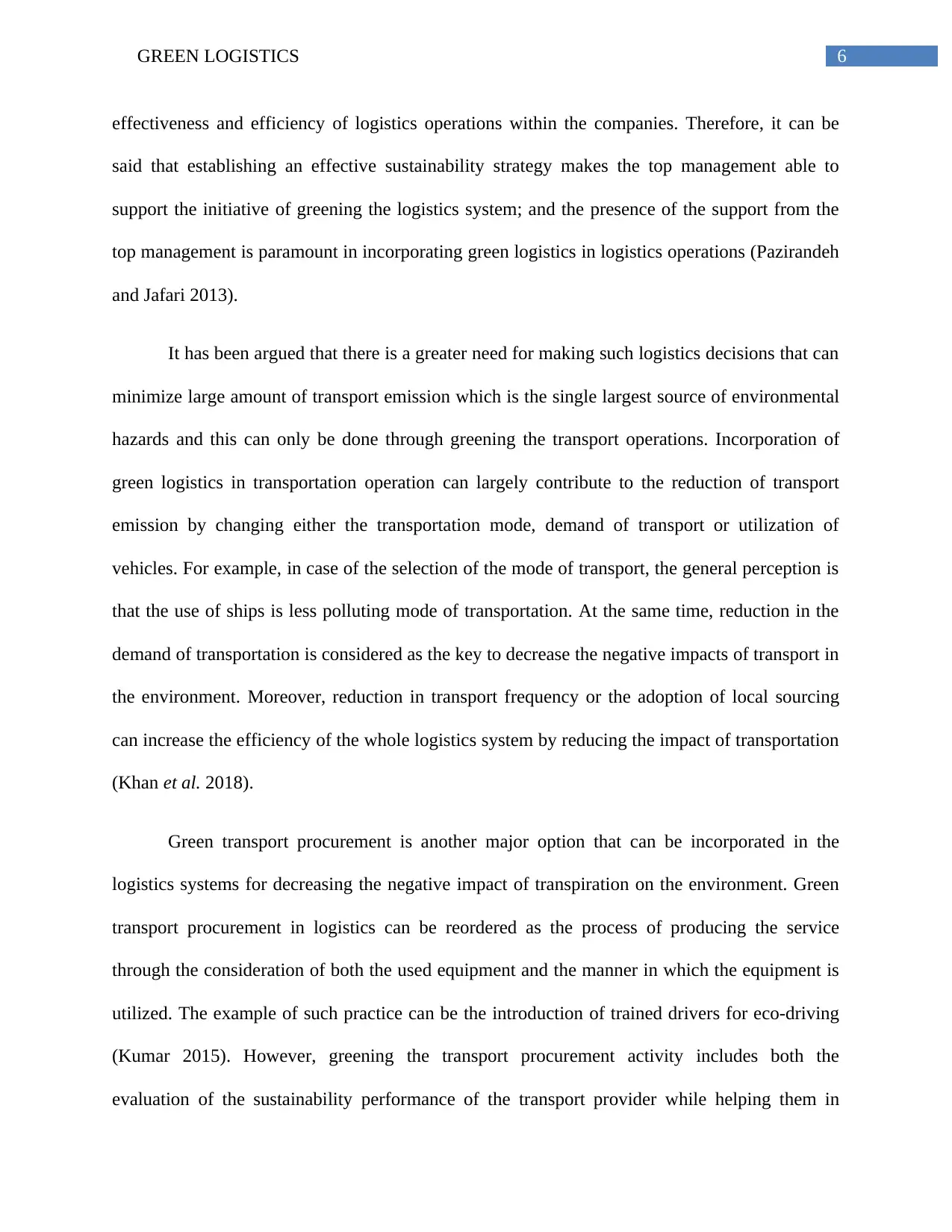
6GREEN LOGISTICS
effectiveness and efficiency of logistics operations within the companies. Therefore, it can be
said that establishing an effective sustainability strategy makes the top management able to
support the initiative of greening the logistics system; and the presence of the support from the
top management is paramount in incorporating green logistics in logistics operations (Pazirandeh
and Jafari 2013).
It has been argued that there is a greater need for making such logistics decisions that can
minimize large amount of transport emission which is the single largest source of environmental
hazards and this can only be done through greening the transport operations. Incorporation of
green logistics in transportation operation can largely contribute to the reduction of transport
emission by changing either the transportation mode, demand of transport or utilization of
vehicles. For example, in case of the selection of the mode of transport, the general perception is
that the use of ships is less polluting mode of transportation. At the same time, reduction in the
demand of transportation is considered as the key to decrease the negative impacts of transport in
the environment. Moreover, reduction in transport frequency or the adoption of local sourcing
can increase the efficiency of the whole logistics system by reducing the impact of transportation
(Khan et al. 2018).
Green transport procurement is another major option that can be incorporated in the
logistics systems for decreasing the negative impact of transpiration on the environment. Green
transport procurement in logistics can be reordered as the process of producing the service
through the consideration of both the used equipment and the manner in which the equipment is
utilized. The example of such practice can be the introduction of trained drivers for eco-driving
(Kumar 2015). However, greening the transport procurement activity includes both the
evaluation of the sustainability performance of the transport provider while helping them in
effectiveness and efficiency of logistics operations within the companies. Therefore, it can be
said that establishing an effective sustainability strategy makes the top management able to
support the initiative of greening the logistics system; and the presence of the support from the
top management is paramount in incorporating green logistics in logistics operations (Pazirandeh
and Jafari 2013).
It has been argued that there is a greater need for making such logistics decisions that can
minimize large amount of transport emission which is the single largest source of environmental
hazards and this can only be done through greening the transport operations. Incorporation of
green logistics in transportation operation can largely contribute to the reduction of transport
emission by changing either the transportation mode, demand of transport or utilization of
vehicles. For example, in case of the selection of the mode of transport, the general perception is
that the use of ships is less polluting mode of transportation. At the same time, reduction in the
demand of transportation is considered as the key to decrease the negative impacts of transport in
the environment. Moreover, reduction in transport frequency or the adoption of local sourcing
can increase the efficiency of the whole logistics system by reducing the impact of transportation
(Khan et al. 2018).
Green transport procurement is another major option that can be incorporated in the
logistics systems for decreasing the negative impact of transpiration on the environment. Green
transport procurement in logistics can be reordered as the process of producing the service
through the consideration of both the used equipment and the manner in which the equipment is
utilized. The example of such practice can be the introduction of trained drivers for eco-driving
(Kumar 2015). However, greening the transport procurement activity includes both the
evaluation of the sustainability performance of the transport provider while helping them in
Paraphrase This Document
Need a fresh take? Get an instant paraphrase of this document with our AI Paraphraser
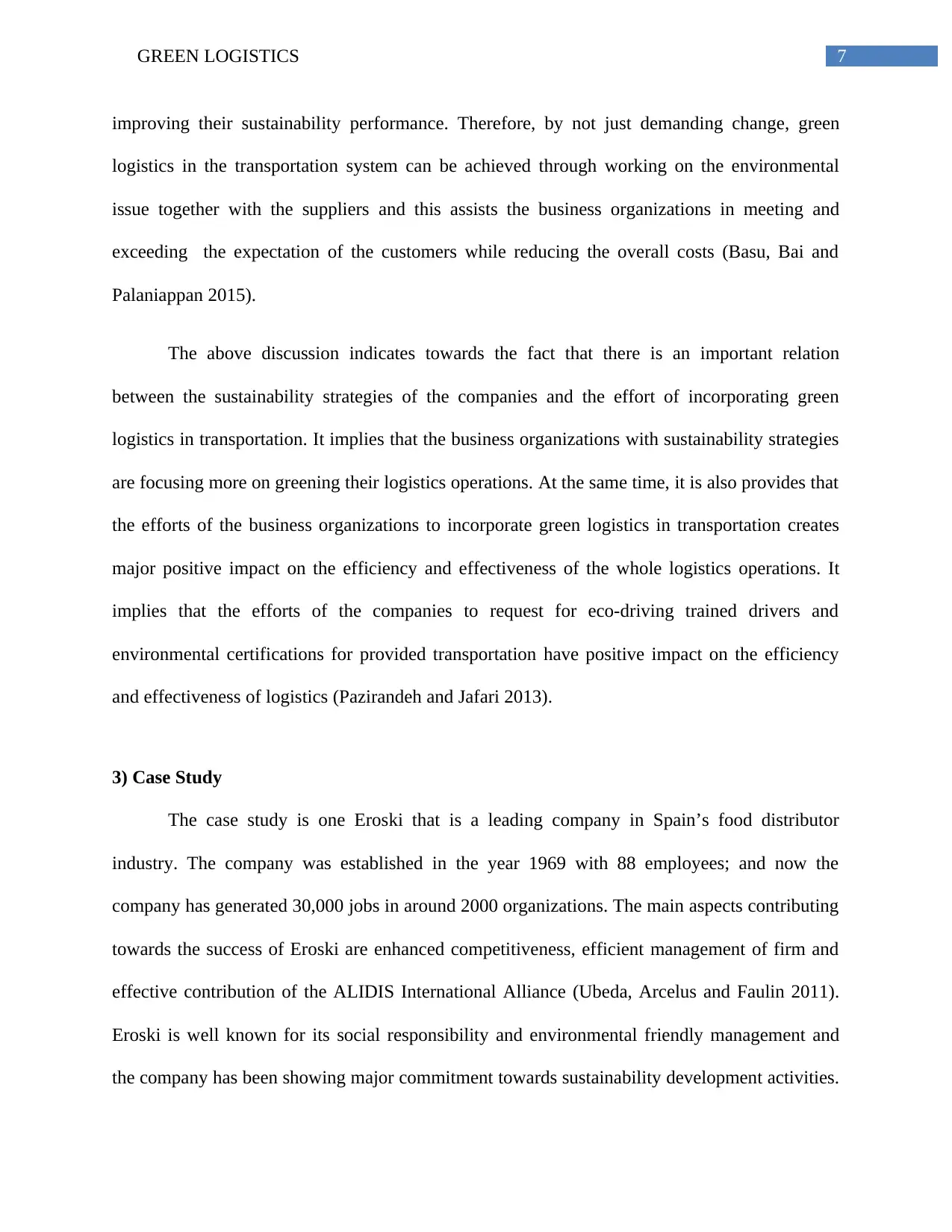
7GREEN LOGISTICS
improving their sustainability performance. Therefore, by not just demanding change, green
logistics in the transportation system can be achieved through working on the environmental
issue together with the suppliers and this assists the business organizations in meeting and
exceeding the expectation of the customers while reducing the overall costs (Basu, Bai and
Palaniappan 2015).
The above discussion indicates towards the fact that there is an important relation
between the sustainability strategies of the companies and the effort of incorporating green
logistics in transportation. It implies that the business organizations with sustainability strategies
are focusing more on greening their logistics operations. At the same time, it is also provides that
the efforts of the business organizations to incorporate green logistics in transportation creates
major positive impact on the efficiency and effectiveness of the whole logistics operations. It
implies that the efforts of the companies to request for eco-driving trained drivers and
environmental certifications for provided transportation have positive impact on the efficiency
and effectiveness of logistics (Pazirandeh and Jafari 2013).
3) Case Study
The case study is one Eroski that is a leading company in Spain’s food distributor
industry. The company was established in the year 1969 with 88 employees; and now the
company has generated 30,000 jobs in around 2000 organizations. The main aspects contributing
towards the success of Eroski are enhanced competitiveness, efficient management of firm and
effective contribution of the ALIDIS International Alliance (Ubeda, Arcelus and Faulin 2011).
Eroski is well known for its social responsibility and environmental friendly management and
the company has been showing major commitment towards sustainability development activities.
improving their sustainability performance. Therefore, by not just demanding change, green
logistics in the transportation system can be achieved through working on the environmental
issue together with the suppliers and this assists the business organizations in meeting and
exceeding the expectation of the customers while reducing the overall costs (Basu, Bai and
Palaniappan 2015).
The above discussion indicates towards the fact that there is an important relation
between the sustainability strategies of the companies and the effort of incorporating green
logistics in transportation. It implies that the business organizations with sustainability strategies
are focusing more on greening their logistics operations. At the same time, it is also provides that
the efforts of the business organizations to incorporate green logistics in transportation creates
major positive impact on the efficiency and effectiveness of the whole logistics operations. It
implies that the efforts of the companies to request for eco-driving trained drivers and
environmental certifications for provided transportation have positive impact on the efficiency
and effectiveness of logistics (Pazirandeh and Jafari 2013).
3) Case Study
The case study is one Eroski that is a leading company in Spain’s food distributor
industry. The company was established in the year 1969 with 88 employees; and now the
company has generated 30,000 jobs in around 2000 organizations. The main aspects contributing
towards the success of Eroski are enhanced competitiveness, efficient management of firm and
effective contribution of the ALIDIS International Alliance (Ubeda, Arcelus and Faulin 2011).
Eroski is well known for its social responsibility and environmental friendly management and
the company has been showing major commitment towards sustainability development activities.
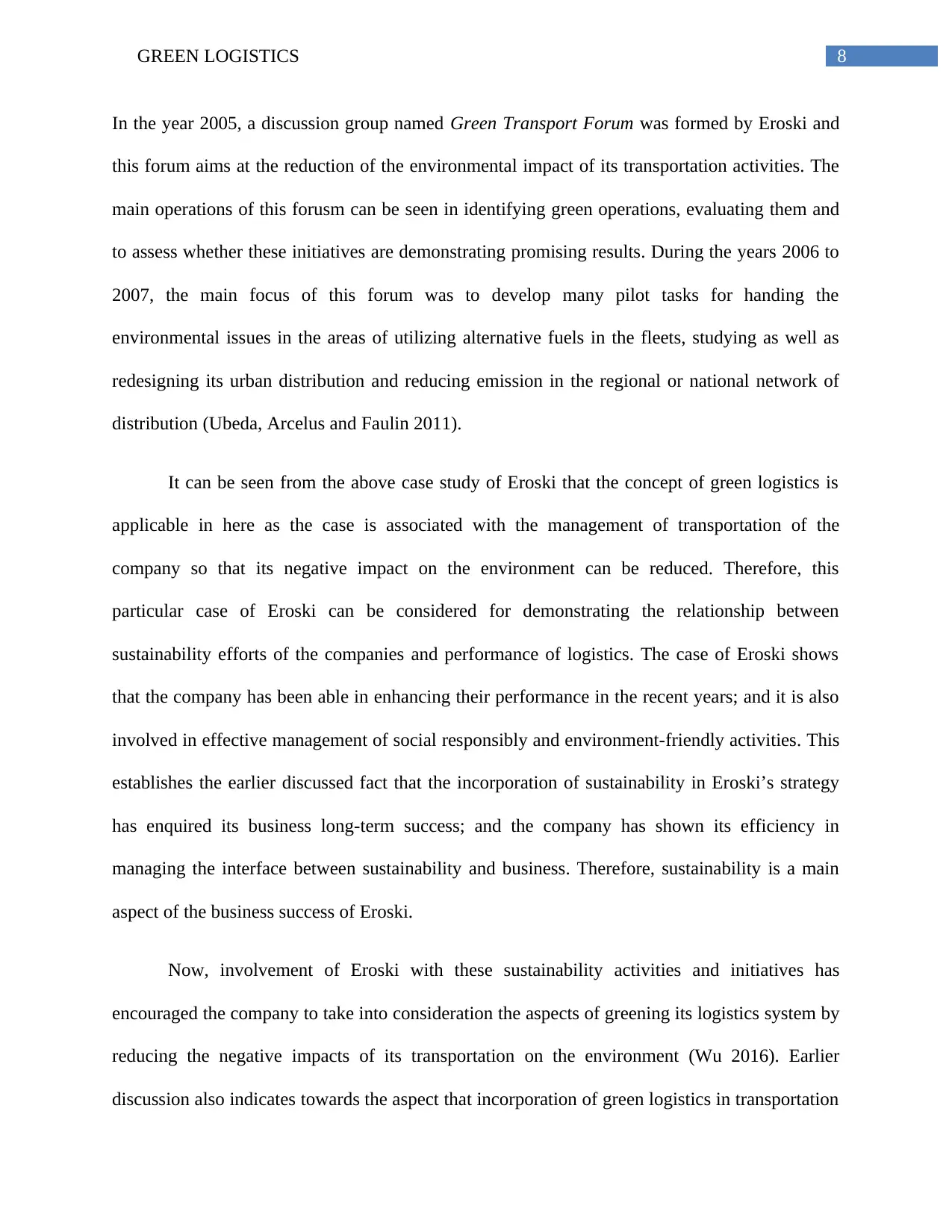
8GREEN LOGISTICS
In the year 2005, a discussion group named Green Transport Forum was formed by Eroski and
this forum aims at the reduction of the environmental impact of its transportation activities. The
main operations of this forusm can be seen in identifying green operations, evaluating them and
to assess whether these initiatives are demonstrating promising results. During the years 2006 to
2007, the main focus of this forum was to develop many pilot tasks for handing the
environmental issues in the areas of utilizing alternative fuels in the fleets, studying as well as
redesigning its urban distribution and reducing emission in the regional or national network of
distribution (Ubeda, Arcelus and Faulin 2011).
It can be seen from the above case study of Eroski that the concept of green logistics is
applicable in here as the case is associated with the management of transportation of the
company so that its negative impact on the environment can be reduced. Therefore, this
particular case of Eroski can be considered for demonstrating the relationship between
sustainability efforts of the companies and performance of logistics. The case of Eroski shows
that the company has been able in enhancing their performance in the recent years; and it is also
involved in effective management of social responsibly and environment-friendly activities. This
establishes the earlier discussed fact that the incorporation of sustainability in Eroski’s strategy
has enquired its business long-term success; and the company has shown its efficiency in
managing the interface between sustainability and business. Therefore, sustainability is a main
aspect of the business success of Eroski.
Now, involvement of Eroski with these sustainability activities and initiatives has
encouraged the company to take into consideration the aspects of greening its logistics system by
reducing the negative impacts of its transportation on the environment (Wu 2016). Earlier
discussion also indicates towards the aspect that incorporation of green logistics in transportation
In the year 2005, a discussion group named Green Transport Forum was formed by Eroski and
this forum aims at the reduction of the environmental impact of its transportation activities. The
main operations of this forusm can be seen in identifying green operations, evaluating them and
to assess whether these initiatives are demonstrating promising results. During the years 2006 to
2007, the main focus of this forum was to develop many pilot tasks for handing the
environmental issues in the areas of utilizing alternative fuels in the fleets, studying as well as
redesigning its urban distribution and reducing emission in the regional or national network of
distribution (Ubeda, Arcelus and Faulin 2011).
It can be seen from the above case study of Eroski that the concept of green logistics is
applicable in here as the case is associated with the management of transportation of the
company so that its negative impact on the environment can be reduced. Therefore, this
particular case of Eroski can be considered for demonstrating the relationship between
sustainability efforts of the companies and performance of logistics. The case of Eroski shows
that the company has been able in enhancing their performance in the recent years; and it is also
involved in effective management of social responsibly and environment-friendly activities. This
establishes the earlier discussed fact that the incorporation of sustainability in Eroski’s strategy
has enquired its business long-term success; and the company has shown its efficiency in
managing the interface between sustainability and business. Therefore, sustainability is a main
aspect of the business success of Eroski.
Now, involvement of Eroski with these sustainability activities and initiatives has
encouraged the company to take into consideration the aspects of greening its logistics system by
reducing the negative impacts of its transportation on the environment (Wu 2016). Earlier
discussion also indicates towards the aspect that incorporation of green logistics in transportation
⊘ This is a preview!⊘
Do you want full access?
Subscribe today to unlock all pages.

Trusted by 1+ million students worldwide
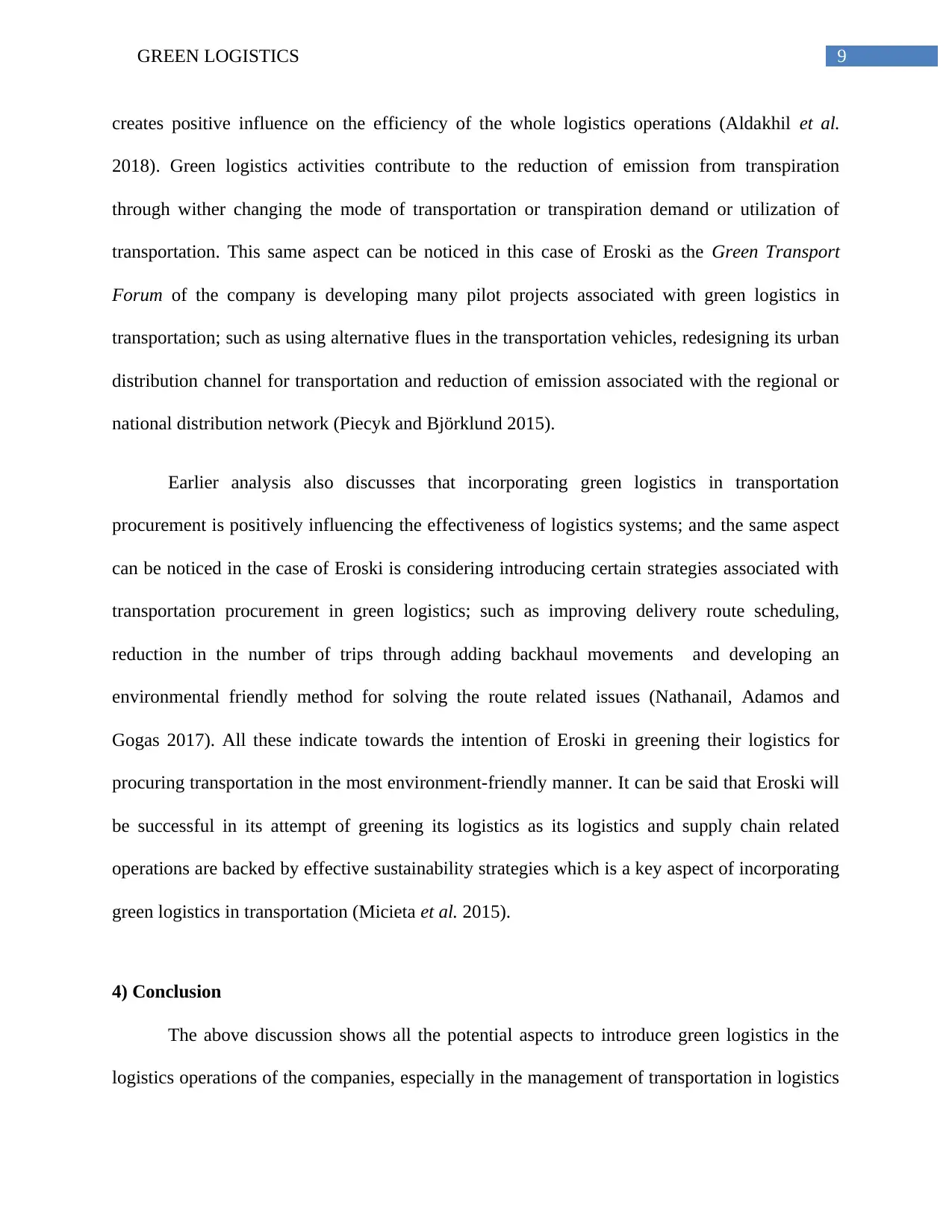
9GREEN LOGISTICS
creates positive influence on the efficiency of the whole logistics operations (Aldakhil et al.
2018). Green logistics activities contribute to the reduction of emission from transpiration
through wither changing the mode of transportation or transpiration demand or utilization of
transportation. This same aspect can be noticed in this case of Eroski as the Green Transport
Forum of the company is developing many pilot projects associated with green logistics in
transportation; such as using alternative flues in the transportation vehicles, redesigning its urban
distribution channel for transportation and reduction of emission associated with the regional or
national distribution network (Piecyk and Björklund 2015).
Earlier analysis also discusses that incorporating green logistics in transportation
procurement is positively influencing the effectiveness of logistics systems; and the same aspect
can be noticed in the case of Eroski is considering introducing certain strategies associated with
transportation procurement in green logistics; such as improving delivery route scheduling,
reduction in the number of trips through adding backhaul movements and developing an
environmental friendly method for solving the route related issues (Nathanail, Adamos and
Gogas 2017). All these indicate towards the intention of Eroski in greening their logistics for
procuring transportation in the most environment-friendly manner. It can be said that Eroski will
be successful in its attempt of greening its logistics as its logistics and supply chain related
operations are backed by effective sustainability strategies which is a key aspect of incorporating
green logistics in transportation (Micieta et al. 2015).
4) Conclusion
The above discussion shows all the potential aspects to introduce green logistics in the
logistics operations of the companies, especially in the management of transportation in logistics
creates positive influence on the efficiency of the whole logistics operations (Aldakhil et al.
2018). Green logistics activities contribute to the reduction of emission from transpiration
through wither changing the mode of transportation or transpiration demand or utilization of
transportation. This same aspect can be noticed in this case of Eroski as the Green Transport
Forum of the company is developing many pilot projects associated with green logistics in
transportation; such as using alternative flues in the transportation vehicles, redesigning its urban
distribution channel for transportation and reduction of emission associated with the regional or
national distribution network (Piecyk and Björklund 2015).
Earlier analysis also discusses that incorporating green logistics in transportation
procurement is positively influencing the effectiveness of logistics systems; and the same aspect
can be noticed in the case of Eroski is considering introducing certain strategies associated with
transportation procurement in green logistics; such as improving delivery route scheduling,
reduction in the number of trips through adding backhaul movements and developing an
environmental friendly method for solving the route related issues (Nathanail, Adamos and
Gogas 2017). All these indicate towards the intention of Eroski in greening their logistics for
procuring transportation in the most environment-friendly manner. It can be said that Eroski will
be successful in its attempt of greening its logistics as its logistics and supply chain related
operations are backed by effective sustainability strategies which is a key aspect of incorporating
green logistics in transportation (Micieta et al. 2015).
4) Conclusion
The above discussion shows all the potential aspects to introduce green logistics in the
logistics operations of the companies, especially in the management of transportation in logistics
Paraphrase This Document
Need a fresh take? Get an instant paraphrase of this document with our AI Paraphraser
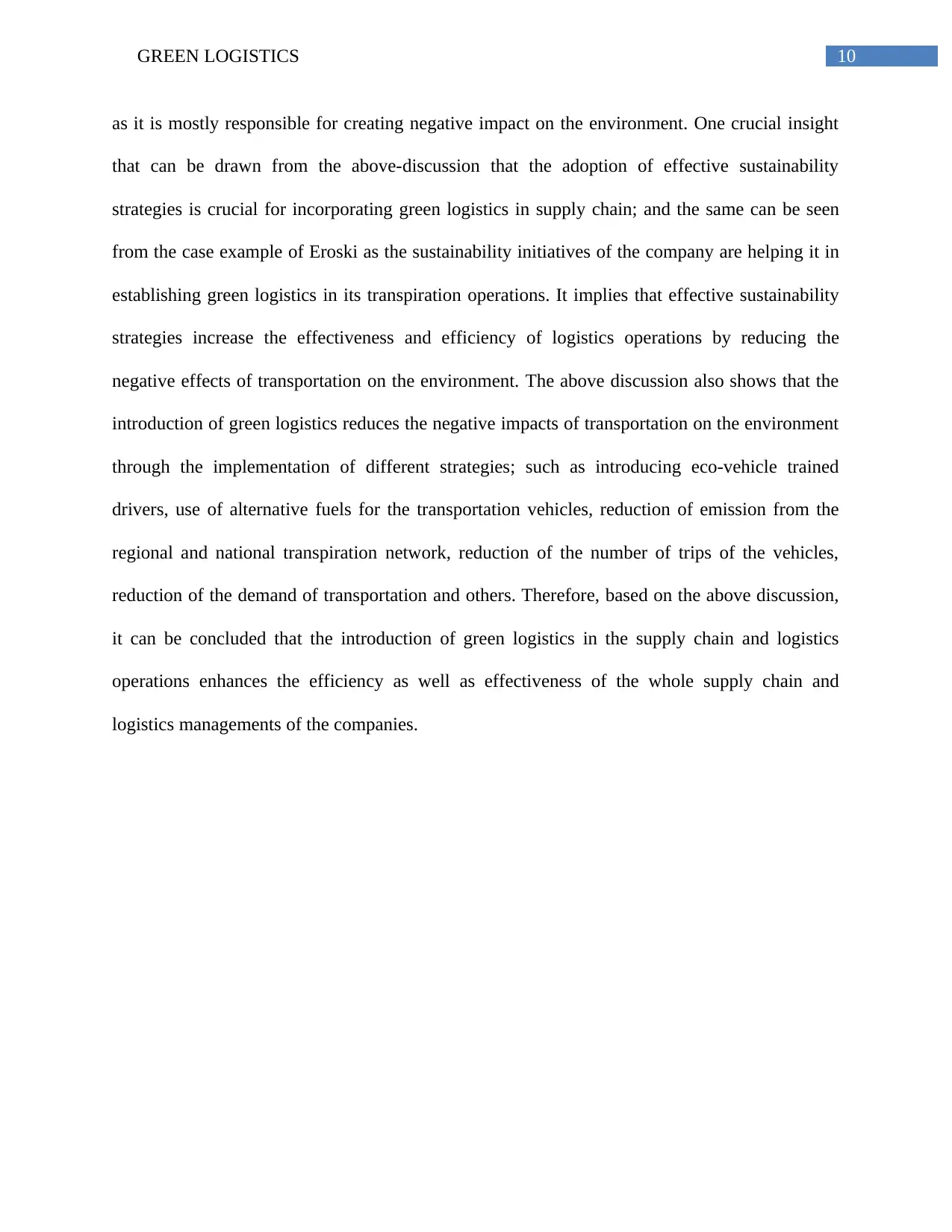
10GREEN LOGISTICS
as it is mostly responsible for creating negative impact on the environment. One crucial insight
that can be drawn from the above-discussion that the adoption of effective sustainability
strategies is crucial for incorporating green logistics in supply chain; and the same can be seen
from the case example of Eroski as the sustainability initiatives of the company are helping it in
establishing green logistics in its transpiration operations. It implies that effective sustainability
strategies increase the effectiveness and efficiency of logistics operations by reducing the
negative effects of transportation on the environment. The above discussion also shows that the
introduction of green logistics reduces the negative impacts of transportation on the environment
through the implementation of different strategies; such as introducing eco-vehicle trained
drivers, use of alternative fuels for the transportation vehicles, reduction of emission from the
regional and national transpiration network, reduction of the number of trips of the vehicles,
reduction of the demand of transportation and others. Therefore, based on the above discussion,
it can be concluded that the introduction of green logistics in the supply chain and logistics
operations enhances the efficiency as well as effectiveness of the whole supply chain and
logistics managements of the companies.
as it is mostly responsible for creating negative impact on the environment. One crucial insight
that can be drawn from the above-discussion that the adoption of effective sustainability
strategies is crucial for incorporating green logistics in supply chain; and the same can be seen
from the case example of Eroski as the sustainability initiatives of the company are helping it in
establishing green logistics in its transpiration operations. It implies that effective sustainability
strategies increase the effectiveness and efficiency of logistics operations by reducing the
negative effects of transportation on the environment. The above discussion also shows that the
introduction of green logistics reduces the negative impacts of transportation on the environment
through the implementation of different strategies; such as introducing eco-vehicle trained
drivers, use of alternative fuels for the transportation vehicles, reduction of emission from the
regional and national transpiration network, reduction of the number of trips of the vehicles,
reduction of the demand of transportation and others. Therefore, based on the above discussion,
it can be concluded that the introduction of green logistics in the supply chain and logistics
operations enhances the efficiency as well as effectiveness of the whole supply chain and
logistics managements of the companies.
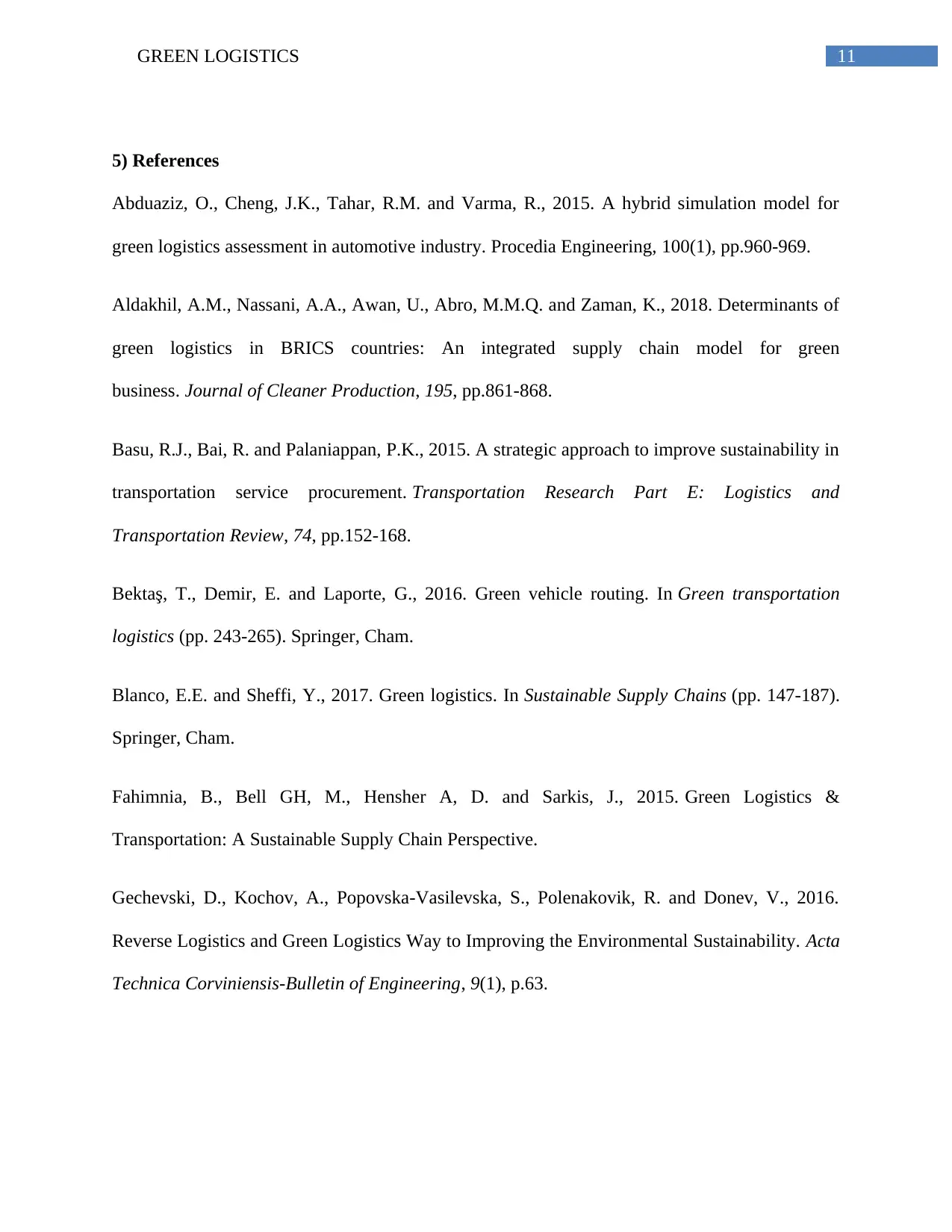
11GREEN LOGISTICS
5) References
Abduaziz, O., Cheng, J.K., Tahar, R.M. and Varma, R., 2015. A hybrid simulation model for
green logistics assessment in automotive industry. Procedia Engineering, 100(1), pp.960-969.
Aldakhil, A.M., Nassani, A.A., Awan, U., Abro, M.M.Q. and Zaman, K., 2018. Determinants of
green logistics in BRICS countries: An integrated supply chain model for green
business. Journal of Cleaner Production, 195, pp.861-868.
Basu, R.J., Bai, R. and Palaniappan, P.K., 2015. A strategic approach to improve sustainability in
transportation service procurement. Transportation Research Part E: Logistics and
Transportation Review, 74, pp.152-168.
Bektaş, T., Demir, E. and Laporte, G., 2016. Green vehicle routing. In Green transportation
logistics (pp. 243-265). Springer, Cham.
Blanco, E.E. and Sheffi, Y., 2017. Green logistics. In Sustainable Supply Chains (pp. 147-187).
Springer, Cham.
Fahimnia, B., Bell GH, M., Hensher A, D. and Sarkis, J., 2015. Green Logistics &
Transportation: A Sustainable Supply Chain Perspective.
Gechevski, D., Kochov, A., Popovska-Vasilevska, S., Polenakovik, R. and Donev, V., 2016.
Reverse Logistics and Green Logistics Way to Improving the Environmental Sustainability. Acta
Technica Corviniensis-Bulletin of Engineering, 9(1), p.63.
5) References
Abduaziz, O., Cheng, J.K., Tahar, R.M. and Varma, R., 2015. A hybrid simulation model for
green logistics assessment in automotive industry. Procedia Engineering, 100(1), pp.960-969.
Aldakhil, A.M., Nassani, A.A., Awan, U., Abro, M.M.Q. and Zaman, K., 2018. Determinants of
green logistics in BRICS countries: An integrated supply chain model for green
business. Journal of Cleaner Production, 195, pp.861-868.
Basu, R.J., Bai, R. and Palaniappan, P.K., 2015. A strategic approach to improve sustainability in
transportation service procurement. Transportation Research Part E: Logistics and
Transportation Review, 74, pp.152-168.
Bektaş, T., Demir, E. and Laporte, G., 2016. Green vehicle routing. In Green transportation
logistics (pp. 243-265). Springer, Cham.
Blanco, E.E. and Sheffi, Y., 2017. Green logistics. In Sustainable Supply Chains (pp. 147-187).
Springer, Cham.
Fahimnia, B., Bell GH, M., Hensher A, D. and Sarkis, J., 2015. Green Logistics &
Transportation: A Sustainable Supply Chain Perspective.
Gechevski, D., Kochov, A., Popovska-Vasilevska, S., Polenakovik, R. and Donev, V., 2016.
Reverse Logistics and Green Logistics Way to Improving the Environmental Sustainability. Acta
Technica Corviniensis-Bulletin of Engineering, 9(1), p.63.
⊘ This is a preview!⊘
Do you want full access?
Subscribe today to unlock all pages.

Trusted by 1+ million students worldwide
1 out of 14
Related Documents
Your All-in-One AI-Powered Toolkit for Academic Success.
+13062052269
info@desklib.com
Available 24*7 on WhatsApp / Email
![[object Object]](/_next/static/media/star-bottom.7253800d.svg)
Unlock your academic potential
Copyright © 2020–2025 A2Z Services. All Rights Reserved. Developed and managed by ZUCOL.




